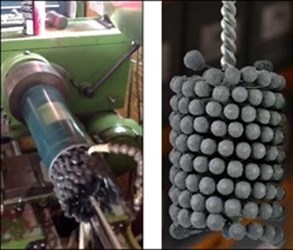Ball Hones For Pneumatic Cylinders: BRM Announces Video Showing How Ball Honing Improves Cylinder Surface Finish; Flex-Hone® User Rotates Part Instead Of Cylinder Hone

Brush Research Manufacturing (BRM), Made in the USA maker of flexible cylinder hones and full line of industrial brushes, announces user feedback about Flex-Hone® tools for air cylinders. YouTube video shows how rotating the workpiece instead of the flexible honing tool imparts a superior surface finish on cylinder walls, promoting optimum lubrication and seal life.
Los Angeles, CA (PRWEB) - Brush Research Manufacturing (BRM), global supplier of surface finishing solutions, is announcing user feedback about its Flex-Hone® tool for cylinder wall surface finishing. In a YouTube video entitled “Ball Honing a Pneumatic Cylinder,” a Flex-Hone® user demonstrates how rotating the workpiece instead of the flexible cylinder hone can also impart a superior surface finish.
Flexible cylinder hones are low RPM tools, and speed is dependent upon tool diameter. Typically, users secure the ball hone in a collet, chuck, or similar holding device and then rotate the tool along with the spindle. As this short YouTube video demonstrates, however, it’s also possible to rotate the part instead, as with ball honing pneumatic cylinders.
Cylinder Wall Surface Finish
Pneumatic cylinders are mechanical devices that use a compressed gas (such as air) to move a piston in a reciprocating, linear motion. In single-acting cylinders (SAC), the compressed gas forces the piston in only one direction, usually outward, and a spring provides the return motion. In double-acting cylinders (DAC), pressure causes the piston to extend and then retract.
If the walls of pneumatic cylinders are too smooth, there’s greater adhesion friction between cylinder seals and bore surfaces. The absence of oil-retaining grooves can also affect lubrication. If the walls of an air cylinder are too rough, metal burrs and other surface irregularities can shear softer O-ring materials like rubber. If seal failure occurs, pressure may be lost and overall performance may suffer.
Ball Honing Pneumatic Cylinders
To protect the integrity of fluid power systems, manufacturers and maintenance personnel need to ensure that bores have a proper surface finish. The Flex-Hone® tool from Brush Research Manufacturing (BRM) removes burrs and improves surface condition at the same time. Suitable for any type or size cylinder, these flexible honing tools also impart a series of oil-retaining grooves for optimum lubrication.
As BRM’s Gold Booklet explains, the Flex-Hone® produces a crosshatch pattern of evenly-spaced “valleys”. Flexible cylinder hones also remove torn, cut, folded, and jagged metal while reducing raised areas or “peaks” to a uniform height. BRM ball hones feature distinctive abrasive globules, and use a low-temperature, low-pressure cutting action for surface finishing and burr removal.
Flexible hones also have a double-wire metal stem for mounting in handheld power tools or production machinery. Because these cylinder honing tools are self-centering, self-aligning to the bore, and self-compensating for wear, no special training is required. For information about tool selection and general guidelines for use, download the Flex-Hone® Resource Guide.
About Brush Research Manufacturing
Brush Research Manufacturing (BRM), maker of flexible honing tools and nylon abrasive brushes, is located in Los Angeles, California. For 55 years, we’ve been solving difficult finishing problems with brushing technology. BRM’s Flex-Hone® tool is the standard against which all other cylinder hones are compared. For outer diameter (OD) deburring and surface finishing, choose NamPower brush tools.
Source: PRWeb
View original release here: http://www.prweb.com/releases/2014/06/prweb11914382.htm
